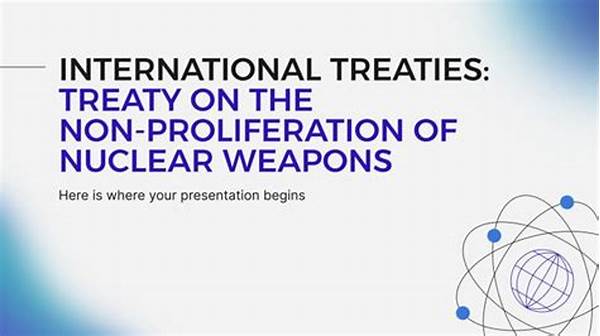Nuclear risk has remained a critical concern for the global community due to the devastating potential of nuclear weapons and accidents. As a response, international treaties on nuclear risk reduction have been established with the aim of maintaining global peace and security. These treaties serve as a framework for cooperation among nations, emphasizing disarmament, non-proliferation, and the safe use of nuclear technology. By establishing legal and procedural measures, these international agreements contribute to mitigating the risks associated with nuclear threats, thereby ensuring a secure international environment.
Historical Context and Development
International treaties on nuclear risk reduction have evolved over time, reflecting the changing dynamics of global politics and the advancements in nuclear technology. The inception of such treaties can be traced back to the Cold War era when the threat of nuclear annihilation was at its peak. The Treaty on the Non-Proliferation of Nuclear Weapons (NPT), enacted in 1970, became a cornerstone for preventing the spread of nuclear weapons. Further advancements were made in subsequent years, with treaties such as the Comprehensive Nuclear-Test-Ban Treaty (CTBT) and various bilateral agreements aimed at reducing existing nuclear arsenals. These treaties not only underscored the mutual reliance on international cooperation for security but also sought to balance the rights of states to use nuclear technology for peaceful purposes.
Key Provisions of International Treaties
1. Non-Proliferation: Central to international treaties on nuclear risk reduction is the commitment to prevent the proliferation of nuclear weapons, ensuring that nuclear capabilities are constrained to recognized nuclear-armed states.
2. Disarmament: Efforts to disarm existing nuclear arsenals are a vital component, as demonstrated by treaties mandating reductions in the number of nuclear warheads.
3. Peaceful Use of Nuclear Energy: Encouraging the use of nuclear energy for peaceful purposes while preventing its diversion to weaponization forms a pivotal part of these international agreements.
4. Verification and Compliance: Treaties often necessitate robust mechanisms for verification and compliance to ensure that signatories adhere to their commitments, thus building trust among states.
5. Security Assurances: International treaties provide security assurances to non-nuclear weapon states, enhancing their safety and diminishing the need for developing independent nuclear deterrents.
Challenges in Implementation
Implementing international treaties on nuclear risk reduction poses several challenges. The verification and enforcement of treaty obligations rely on international trust and cooperation, which can be hindered by geopolitical tensions. Additionally, technological advancements have made monitoring nuclear materials and activities more complex. The lack of universal participation, with some states refraining from joining key treaties, further complicates enforcement efforts. Moreover, the disparity in nuclear capabilities among nations can create imbalances and foster regional insecurities. Despite these adversities, the continuous pursuit of diplomacy and multilateral negotiations remains crucial in overcoming these barriers.
Notable Treaties on Nuclear Risk Reduction
Various notable international treaties on nuclear risk reduction have made significant strides in promoting global nuclear security. The Treaty on the Non-Proliferation of Nuclear Weapons (NPT) remains a landmark agreement, embodying the three pillars of non-proliferation, disarmament, and peaceful nuclear energy use. The Comprehensive Nuclear-Test-Ban Treaty (CTBT) aims to ban all nuclear explosions, serving as a preventive measure against further nuclear development. Furthermore, bilateral treaties such as the Strategic Arms Reduction Treaty (START) and the New START Treaty between the United States and Russia have been instrumental in reducing deployed strategic nuclear arsenals. These treaties continue to play pivotal roles in fostering cooperation and stability on a global scale.
Future Prospects and Directions
The future of international treaties on nuclear risk reduction lies in continuous advancements and adaptation to new challenges and threats. Strengthening verification measures and enhancing technological capabilities for monitoring are crucial steps. There is a need for greater inclusivity, encouraging reluctant states to join global efforts towards risk reduction. Diplomatic engagement and confidence-building measures can facilitate broader participation and compliance. Moreover, addressing emerging threats such as cyber-attacks on nuclear facilities and the development of new nuclear technologies requires updated frameworks and agreements. The international community must unite to face these evolving challenges with renewed commitment and collaboration.
Conclusion
In conclusion, international treaties on nuclear risk reduction are indispensable instruments in ensuring global peace and security. By fostering cooperation and establishing legal frameworks, these treaties play a significant role in minimizing nuclear threats and promoting disarmament. Despite the challenges and complexities associated with implementation, international treaties provide a foundation for international dialogue and trust-building, essential for tackling the nuclear risks of the modern world. The continuous evolution and adaptation of these treaties in response to new technological and geopolitical landscapes remain crucial in the ongoing quest for a secure and peaceful global community. Through collective effort and unwavering dedication, the international community can strive towards a future free from the shadows of nuclear peril.





